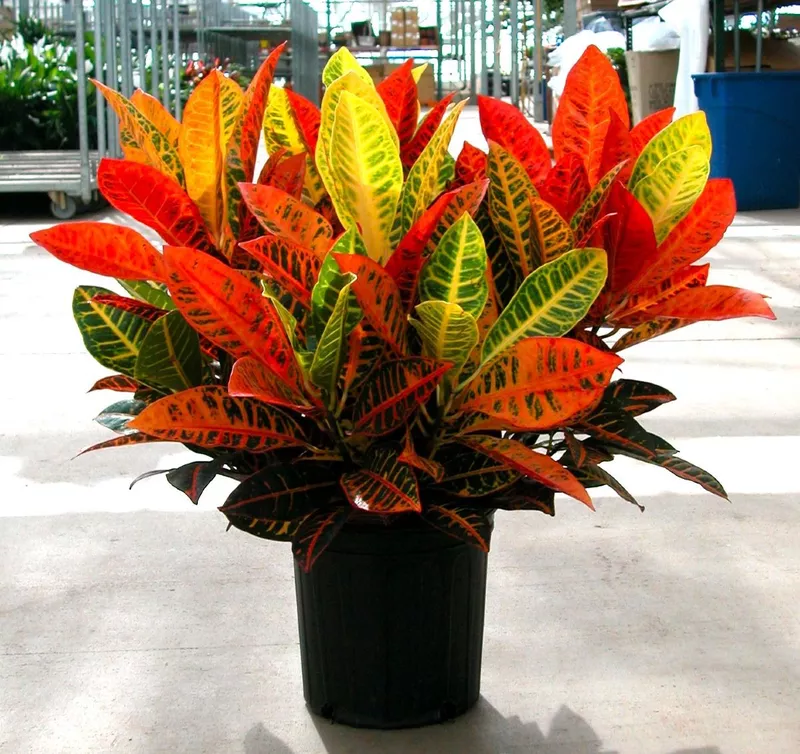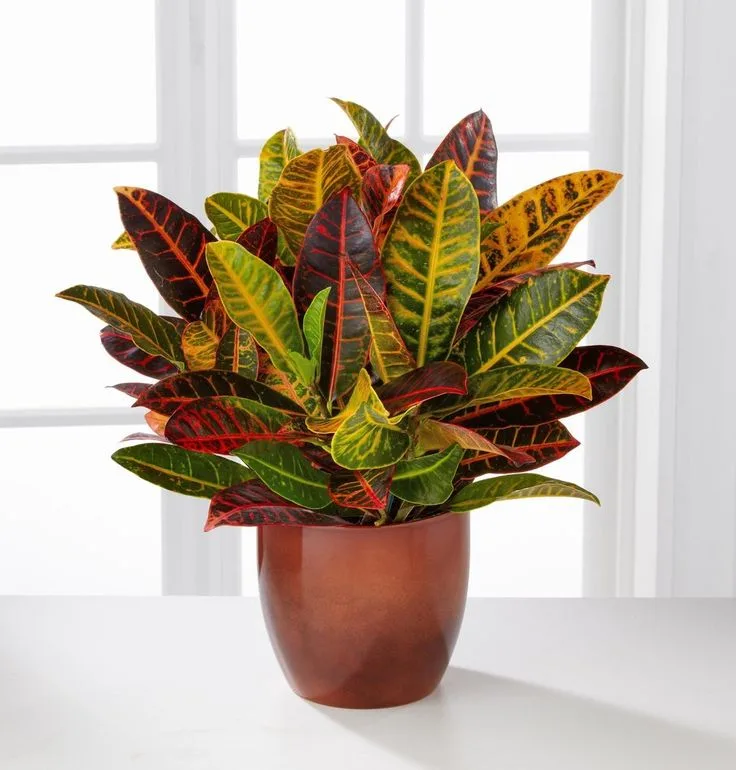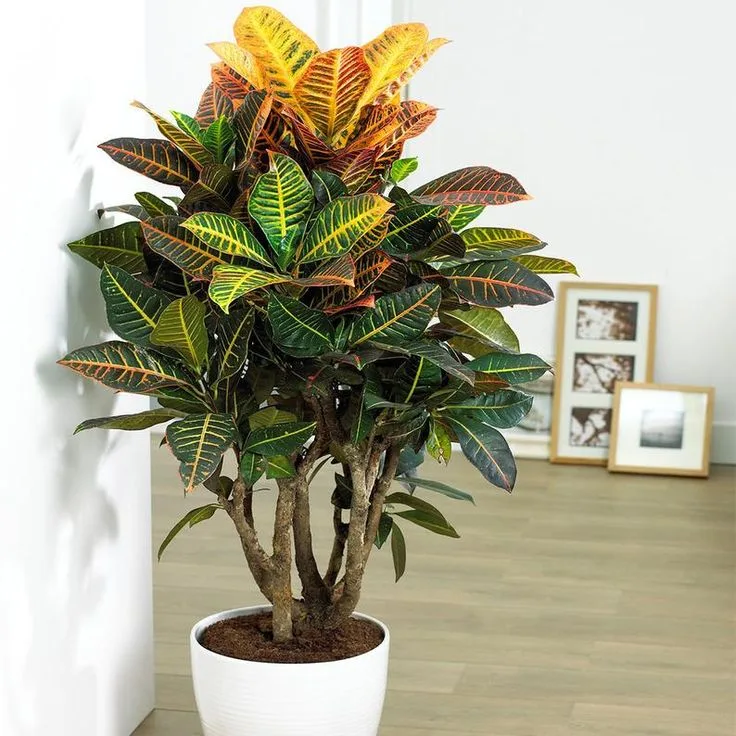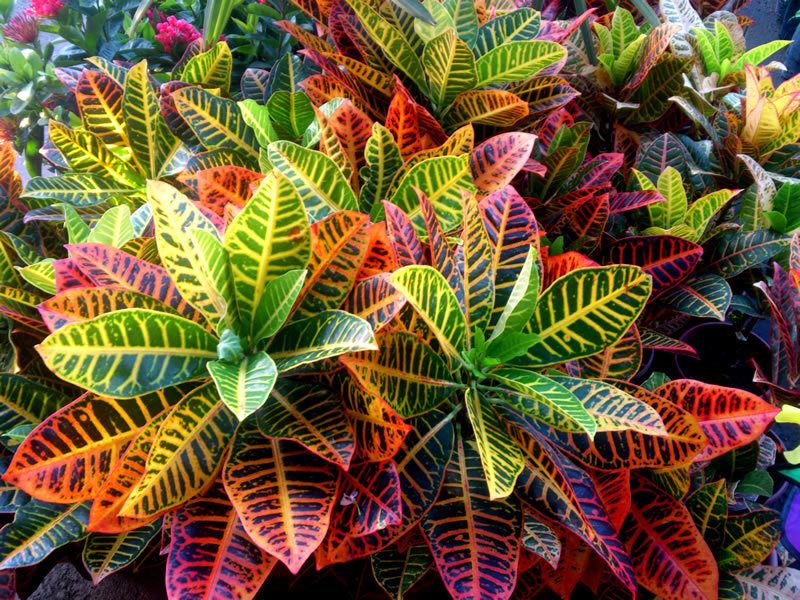index
Presentation
Croton (Croton codiaeum) captivates plant enthusiasts with its vibrant and diverse foliage, transforming gardens and indoor spaces into veritable spectacles of color. Originally from Southeast Asia, this evergreen shrub stands out for its leaves of varying shapes and shades, ranging from bright yellows to deep reds. Croton’s variety of patterns and colors makes it a popular choice for those looking for an explosion of color and an easy-to-grow plant.
The Meaning of Croton
In addition to its visual beauty, Croton carries symbolic meanings. Known for representing vitality and diversity, its multicoloured leaves symbolize wealth and abundance in nature. By introducing Croton into your space, you not only add a tropical touch, but also incorporate a visual representation of energy and prosperity. Find out more about Croton, from its distinctive characteristics to the symbolism it brings to your environment.
| Common Name | Croton |
|---|---|
| Botanical Name | Croton codiaeum |
| Family | Euphorbiaceae |
| Type of Plant | Evergreen shrub |
| Adult size | Varies from 1 to 3 meters |
| Solar Exhibition | Full sun to half shade |
| Soil Type | Well-drained, rich in organic matter |
| Soil pH | Slightly acidic to neutral |
| Flowering Season | Varies depending on the variety |
| Color of Flowers | Insignificant flowers, the colorful leaves stand out |
| Native Area | Southeast Asia |
| Toxicity | Potentially toxic to pets and humans if ingested |

How to Care for Croton
Appropriate Light
In order to guarantee the exuberant development of Croton, it is essential to provide the right amount of light. Full sun to half shade is ideal, allowing the colorful leaves to stand out. Avoid prolonged exposure to direct sunlight, especially in regions with a hot climate.
Well Prepared Soil
Croton thrives in well-drained soils rich in organic matter. Make sure you offer balanced soil, allowing water to flow easily to avoid excessive moisture build-up, which can damage the roots.
Rega Adequada
Maintaining a consistent watering regime is crucial for successful cultivation. Croton appreciates slightly moist soil, but avoid overwatering, as waterlogging can lead to root problems. Adjust the frequency of watering according to the plant’s needs and the weather conditions.
Ideal Climate and Humidity
Croton prefers warmer temperatures, between 18°C and 25°C. In addition, providing moderate humidity is beneficial, especially in drier environments. Spraying water on the leaves occasionally can help maintain an adequate level of humidity around the plant.
Strategic Fertilization
Croton should be fertilized during the period of active growth, in spring and summer. Use a balanced fertilizer and follow the manufacturer’s instructions. Avoid fertilizing during the winter months, when growth is slower.
By following these care guidelines, you will ensure a healthy and vibrant Croton, transforming your space with its colorful and lively leaves.
How to Make Croton Seedlings
Choice of Material
Before starting the propagation process, make sure you select a healthy and vigorous Croton to obtain quality cuttings. Choose branches that show no signs of disease or damage.
Staking Technique
- Cutting: Use sharp pruning shears to make a clean cut on a healthy branch. The cut should be about 10 to 15 centimeters long.
- Removal of Lower Leaves: Carefully remove the lower leaves, leaving just a few at the end of the branch.
- Rooting: Plant the cutting in a light, well-drained substrate. Keep the soil moist until the roots develop.
How to Plant Croton
- Soil preparation: Make sure the soil is rich in organic matter and well-drained. Add organic compost to improve fertility.
- Suitable spacing: Plant the Croton seedlings keeping a suitable spacing between them, usually around 30 to 60 centimeters apart.
- Planting Depth: Plant the seedlings at the same depth as they were in the original container. Squeeze the soil around the roots to ensure a good hold.
- Initial watering: After planting, carry out a generous initial watering to establish the seedlings in the soil.
By following these simple steps for making seedlings and planting Croton, you’ll be well on your way to creating a garden full of color and vitality.

Pests and Diseases in Croton
Most Common Pests and Diseases:
- Mites: Keep an eye out for small dots on the foliage and fine webs. Use a spray of water or neem oil for control.
- Bugs: White, sticky spots may indicate infestation. Remove by hand or use insecticidal soap.
- Aphids: Small insects that suck the sap from the leaves. Control with water jets or specific insecticides.
- Fungi: Dark spots on the leaves can be a sign of fungal infections. Avoid excess humidity and use fungicides.
Common Problems and Their Solutions:
- Yellowing leaves: This could be a lack of nutrients. Fertilize with a balanced fertilizer.
- Leaf fall: Excess water or lack of light can cause leaf fall. Adjust growing conditions.
- Burned tips: Indicates excessive sun exposure. Move the plant to a place with more diffused light.
- Stagnation in Growth: Check that there are enough nutrients in the soil and adjust fertilization as necessary.
By closely monitoring possible signs of trouble and acting proactively, you can keep your Croton healthy and resistant to common growing challenges.

Curiosities and Myths
Fascinating facts:
- Diversity of Varieties: Croton has a wide range of varieties, each displaying unique patterns and colors in their leaves, providing a unique visual experience.
- Leaves That Change Over Time: As Croton leaves age, it is common to observe changes in their shades, creating a dynamic spectacle of colors over time.
- Prosperity Symbolism: In some cultures, Croton is considered a symbol of prosperity and good luck, attracting positive energy to those who grow it.
Myths Debunked:
- Planting Belief for Protection: Although Croton is admired for its aesthetic characteristics, there is no scientific evidence to prove its ability to protect against negative energies or bad vibes.
- Myths about Toxicity: Although Croton contains toxic substances, the mere presence of the plant in the home does not pose a significant risk, as long as precautions are taken to keep pets and children away from the leaves.
Exploring these curiosities and debunking myths surrounding Croton adds a fascinating layer to the experience of growing this unique plant.
Conclusion
As we explore the universe of Croton, from its vibrant characteristics to its essential care, it becomes clear that this plant is not just a decorative addition, but a source of charm and vitality. Its multicolored leaves, which range from exuberant shades to unique patterns, transform gardens and indoor environments into captivating visual landscapes.
Growing Croton isn’t just about aesthetics; it’s an experience that involves attentive care, an understanding of the needs of the plant and the ability to overcome common cultivation challenges. From successful propagation to identifying and dealing with pests, every stage of the process contributes to the healthy flowering of this exceptional plant. By bringing Croton into your space, you not only add an explosion of color, but also incorporate a symbol of prosperity and vitality. Let the Croton be not just a plant in your garden, but a living witness to the beauty that can be cultivated with love and dedication.
Frequently Asked Questions
What is the spiritual significance of the croton plant?
The croton is often associated with positive spiritual symbolism and is considered a representative of vitality and energy. Its vibrant leaves and diverse colors are interpreted as symbols of joy, prosperity and positivity, attracting good vibes to the environment in which it is grown.
How to look after a croton?
Caring for a croton involves paying attention to a few key points. It thrives in environments with indirect light and well-drained soil. Watering should be moderate, avoiding excess moisture. Keeping the plant free of pests, pruning as necessary and providing adequate fertilization during periods of active growth are essential practices for healthy cultivation.
Is it good to have croton at home?
Having a croton in your home can bring benefits beyond aesthetics. In addition to its visual beauty, the croton is believed to help purify the air by removing certain toxins. Its presence is also associated with a more cheerful and stimulating environment. However, it is important to consider the toxicity of the leaves for pets and children, taking necessary precautions.








